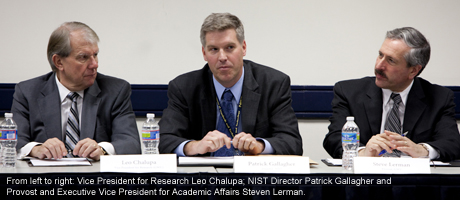By Danny Freedman
For a time of day marked for many people by waning momentum and a hunt for coffee, the two o’clock hour turned out to be pretty fruitful last Thursday for a roomful of GW researchers.
The seminar they attended with top administrators from the National Institute of Standards and Technology, organized by GW’s Office of the Vice President for Research, seemed a bit like speed-dating for scientists—and many researchers walked away with a potential match.
As faculty members stood and told the panel about their research endeavors, just about everyone was met with an encouraging nod from a NIST lab director— “we would be delighted to collaborate with you. …. Please, let’s follow-up on that,” or “That would be lovely; we’d be very interested in that.” Some, like Professor of Economics Fred Joutz, heard directly from NIST Director Patrick Gallagher. “I’m delighted you asked. … I would like to follow-up with you on that.”
The agency, which is part of the U.S. Department of Commerce, employs nearly 3,000 scientists, engineers and other staff on two main campuses: in nearby Gaithersburg, Md., and in Boulder, Colo. But, Dr. Gallagher told the few dozen GW faculty members in attendance, half of the scientists found moving about on NIST campuses are not federal employees; instead, they’re collaborating scientists, stemming largely from universities.
While NIST does have some grant money for researchers to compete for, Dr. Gallagher said “the dominant interaction that we tend to have with universities is peer-to-peer.”
The agency is tasked broadly with supporting “the measurement system of the country,” he said, so the span of its programs is equally broad, reaching into “almost every major science and technology effort that the country has.”
“I think there’s an extremely rich spectrum of things that we could work on,” Dr. Gallagher said.
Over the past decade, researchers from GW and NIST have been co-authors on 91 scholarly journal articles, according to agency figures, and those in turn have been cited as sources nearly 800 times in other journal articles.
Both sides indicated they are interested in building on that. The opportunities—both the research possibilities, and simply being able to arrange a sit-down with NIST brass—show “the tremendous advantage of our location,” said Leo Chalupa, GW’s vice president for research.
The university is hoping to leverage that advantage as research gains momentum at GW. To help foster new collaborations, this fall Dr. Chalupa, President Steven Knapp, Provost Steve Lerman and School of Engineering and Applied Science Dean David Dolling toured facilities at NIST; and earlier in the year Dr. Chalupa’s office hosted Antonio Scarpa, director of the Center for Scientific Research at the National Institutes of Health, in Bethesda, Md., for a talk about winning NIH funding for research.
One person happily seizing on these new connections will be Ed DeFabo, a research professor in GW’s Department of Environmental and Occupational Health.
During the seminar Dr. DeFabo spoke about his hope to translate some of this research into a personal monitor for melanoma risk, which—based on specific sunlight exposure—would warn a person when they’ve been in the sun too long.
Although he can handle the biological aspects, he said, he’d need help with the engineering.
Dr. Gallagher, the NIST director, said that researchers at the agency “would be quite interested in discussing” ideas about personal monitoring.
“It’s a very good program … it’s an excellent idea,” Dr. DeFabo said after the seminar. “It allows for this much more intimate interaction, and you can talk one-on-one sometimes with some of those people. And you get good ideas—I’ve got a great follow-up [at NIST].”
The gathering even helped build connections closer to home. Afterward, while discussing his project, Dr. DeFabo was handed a business card from Mort Friedman, a GW research professor and special assistant for biomedical engineering program development. “Give me a call or send me an email,” he told Dr. DeFabo. “It looks really interesting.”
Dr. DeFabo thanked him, and turned back to the conversation. “Well, there you go,” he said with a smile. “There’s proof positive.”


